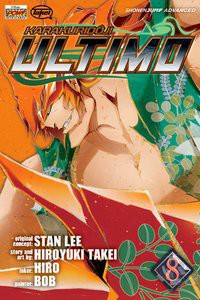RIGHT TURN ONLY!!
I Ain't Even Madoka
by Carlo Santos,

New Year? That means a new anime season! And THAT means new Chihayafuru! Goodness gracious, is this the only thing that gives me a purpose in life anymore?
07-GHOST

Vol. 2
(by Yuki Amemiya and Yukino Ichihara, Viz Media, $9.99)
FROM THE BACK COVER:
"The paths of one evil god, two rival empires, three unlikely bishops and seven brave ghosts converge in the destiny of Teito Klein, a boy who vows to master a powerful artifact known as the Eye of Mikael in order to lay bare the secrets of the world's—and his own—murky past.
In a gambit to steal the power of the Eye of Mikael, a force that has helped the Seven Ghosts keep evil at bay for centuries, the Barsburg Empire sends a most unlikely pursuer to the Barsburg Church after Teito—his best friend Mikage."
EVIDENCE FOR:
Volume 2 of 07-Ghost will rip your heart out—at least that's what it feels like when Teito experiences betrayal and loss at the hands of Mikage. That broken bond of friendship is the dramatic high point of this volume, and a flashback into Teito and Mikage's younger days makes it all the more poignant. Then, if that's not angsty enough, just wait until Teito has to deal with post-traumatic memories and feelings all by himself. The second half of this volume is less of a rollercoaster, but it emphasizes the series' other strength: world-building. As Teito moves forward with his life, training to be a warrior priest, we learn more about the mysteries of the Church that has taken him in. (But they never give away too much; it's those incomplete revelations with puzzle pieces waiting to be filled in that keep readers hooked.) Excellent world-building can also be seen in the artwork, where elaborate costumes and outlandish weapons emphasize the series' fantasy angle. And no matter where the story goes—deep into the fragmented visions of Teito's mind, or out into the chaos of magical battle—the grand, sweeping visuals leave a strong impression.
EVIDENCE AGAINST:
Once again, 07-Ghost comes up with some pretty brilliant moments, but doesn't structure them well. Teito's confrontation with Mikage is heartbreaking, but it happens so haphazardly—a bishop tries to intervene halfway, then a Barsburg military officer comments on the proceedings, and the painful flashback happens after it's all over. Wouldn't it have more impact if we learned of their past before or during the fight? Then there's the sudden shift to Teito's new priestly career, which seems to exist just for the sake of having training sequences and displaying his latent powers. (Shonen cliché alert!) More confusion comes in the action scenes, with odd viewing angles, inexplicable magical attacks, and hard-to-identify characters jumping in. Throw in all the vague explanations and theory about the "Seven Ghosts" that the elders keep talking about, and this series is starting to sound harder than rocket science. Worst of all, if it's not being incomprehensible, it's busy being predictable: Teito spouts boy-hero aphorisms like "I have to live for the sake of those that died!", and a rival character enters the picture later on. Hmm, perhaps Teito's combat training will also involve fighting bosses of increasing difficulty?
FINAL VERDICT:
There are times when it shows promise and expresses some strong emotions, but the series needs way more polish, clarity, and originality. Unless those areas improve, it's stuck with a C-.
BLOOD LAD

Vol. 1
(by Yuuki Kodama, Yen Press, $18.99)
FROM THE BACK COVER:
"The vampire Staz is one of the most powerful district bosses in the demon world. But secretly, the fearsome Staz is obsessed with human culture, especially everything that comes from Japan! When a Japanese girl wanders into the demon world, Staz can't wait to grill her with questions. Regrettably, the demons of Staz's domain make short work of the human, leaving her bare soul behind. But Staz vows to help the girl restore her body and return to her former life—especially since it means taking a trip to the human world himself!"
EVIDENCE FOR:
At first, it sounds like Blood Lad is headed down a predictable comedy path ... so it comes as a pleasant surprise when the series doesn't lapse into repetitive otaku-lifestyle humor. Instead, Staz's misadventures with girl-turned-ghost Fuyumi blossom into something far more entertaining. He gets roped into running an errand at the "Oniqlo" demon clothing store, participates in a boxing match with a werewolf, and reluctantly meets with estranged relatives who only want to humiliate him. And what does this have to do with restoring Fuyumi back to human form? Everything! That's how clever the plot is: a simple attempt at resurrection spirals into one crazy side-quest after another, revealing curious secrets and relationships along the way. Even the side characters face personal challenges—they're not just there to help or hurt Staz, but have goals of their own. Unusual character designs also add to the humor, with a flamboyantly gay ogre and pigeon-headed pedicab drivers, while Staz and his friends' attire flout the old fantasy-genre stereotypes. The sharp, clean-lined artwork during the boxing match, plus a few brawling scenes, also prove that the series has fast-paced action to go with all the comedy.
EVIDENCE AGAINST:
If you want a supernatural-themed comedy that stays on track, this is not the series to pick. The sequence of increasingly bizarre quests seems fun at first, but eventually, it becomes frustrating that everything leads further and further away from Staz helping Fuyumi. In fact, she ends up being little more than a prop, and this becomes painfully evident when her biggest role in the volume's second half is playing a ring girl at the boxing match. Speaking of which, what was the point of the boxing match anyway? Although it makes for good entertainment, the end result does nearly nothing to move the story forward, aside from revealing a couple of points about how magic works in the demon world. Meanwhile, incidents that are relevant to the plot—like Fuyumi starting to disappear from existence—deserve more attention than comedic asides that eat up almost two chapters. The artwork also suffers from misplaced priorities, like the lack of background details in the demon world (a modern-supernatural hybrid setting ought to look fancier than just a generic city). In addition, female characters are lazily drawn from the standard "cute busty girl" stereotype.
FINAL VERDICT:
It's not exactly a high achievement of art or intellect, but the series' unpredictable sense of humor and the intrigue between the different characters is worth a B-.
MESSAGE TO ADOLF

Vol. 2
(by Osamu Tezuka, Vertical, $26.95)
FROM THE BACK COVER:
"In this second and concluding part, the comics master's late masterpiece takes the tale of the three Adolfs beyond the Axis defeat—for the war's damage does not end with it—to the Middle East."
EVIDENCE FOR:
The only thing better than the first half of Message to Adolf ... is the second half. Not only does Tezuka manage to juggle all the storylines from last time, he keeps throwing in new characters and new subplots. The surprise twists and urgent pacing are as addictive as ever, and thankfully the "superman journalist survives every gunshot wound while running across Japan" craziness has been toned down. This volume also weaves in major wartime events, even doing the "angry Hitler" meme long before YouTube ever did. Ultimately, though, it's the personal stories that stick: Adolf Kaufmann's doomed search for his personal and racial identity (plus the even-more-doomed search for Hitler's birth certificate), Adolf Kamil's struggle to maintain his Jewish pride in a world turned against him, and the eye-opening portrayal of Hitler as a flawed, insecure man. Although the art style is simple, that simplicity gets the point across instantly, whether it's a flash of emotion or a split-second action. At the same time, key historical moments are rendered in incredible detail: ravaged buildings and smoldering landscapes serve as visual reminders of the horrors of war, adding even more impact to an unforgettable story.
EVIDENCE AGAINST:
Message to Adolf is so amazing that the worst thing about it is something the publisher did: Vertical's decision to flip the reading direction makes everyone left-handed, forces a violinist to play the instrument from the wrong side, and basically gets really annoying once you start to notice it everywhere. Aside from that, the other problems are basically bad habits that Tezuka fans have learned to put up with. The characters still make comical reaction faces even when the story is being dead serious, and the rubberband limbs when they get into chases and fistfights can be distracting as well. The series also falls into occasional dead-end subplots, where everything seems to be building up to something dramatic (an international spy ring?!) ... only to be brushed aside when sudden events render the whole thing pointless. The story also falls flat when it comes to romantic relationships—male and female characters just rush into love upon first glance, or maybe that's because the story is already so complex, Tezuka hardly has time to develop love stories on top of everything else.
FINAL VERDICT:
Still as brilliant and gripping as when I first read it ten years ago—and now I get to tell the rest of the world why it's so great! This is the kind of stuff that deserves a pure A.
PUELLA MAGI MADOKA MAGICA

Vol. 3
(by Magica Quartet and Hanokage, Yen Press, $11.99)
FROM THE BACK COVER:
"Madoka is horrified to learn the true nature of the witches she and her friends, the Magical Girls, have been fighting—and the terrible fate that awaits any Magical Girl who accepts Kyubey's offer of power. Having watched countless Magical Girls sacrificed for the larger aims of his people, Kyubey is only interested in securing more girls to that end, and Madoka is left with his chilling reminder that she too is destined to be a Magical Girl of incredible power ... Can Madoka and her friends escape this tragic fate?"
EVIDENCE FOR:
In just 3 volumes, the manga is over—but the story of Madoka Magica is as effective on paper as it was on screen. This volume opens with crushing tragedy, as a former foe desperately tries to save a friend, and Madoka can only watch. Then it moves to the incredible, mind-boggling time-travel chapter that blows away everyone's expectations. For those who thought this was just magical fantasy, here comes an advanced physics lesson! But the real clincher comes in the last two chapters, where logic and emotion are pushed and pulled to their very limits: every fantasy story is about saving the world, but it's never been saved quite like this. The final arc tests the very meaning of human existence—and comes out with an uplifting conclusion about love and life. The art comes alive with surreal energy as the Magical Girls battle against fate, but it can also dial down for some simple yet moving scenes between Madoka, Homura, and friends. Furthermore, the abstract imagery near the end defies categorization, but makes a dramatic mark in its own way. And as always, a special mention goes out to Kyubey for the incredibly creepy faces.
EVIDENCE AGAINST:
There are times when Madoka Magica's visual designs seems to be trying to match the anime, not realizing that black-and-white manga and color animation are quite different things. Some scenes are too chaotic, bringing in every little detail from the original concept art, but leaving no room to show the characters in action. Is Kyouko trying to defend herself? Is Homura brandishing a weapon? Who knows, they're just falling through witchspace and drowning under all the art! A similar-but-reverse problem comes up in the final chapter, where the characters end up drowning under all the words instead—Madoka's final transformation segues into a rambling, philosophical conversation about fate and friendship, which could easily have been trimmed by several pages and left more space for the epilogue. The scene where Kyubey and Madoka argue about the Magical Girl system is also pretty talky: yes, it's necessary, but probably could have been broken up into smaller, shorter moments to avoid looking like a wall of text. Some confusion might also result from the time-travel chapter, the way it makes sudden transitions without really signaling them.
FINAL VERDICT:
Too much art? Too much text? The only Madoka Magica has too much of is awesomeness, and this finale is a heartbreaker and mindbender worthy of an A-.
ULTIMO

Vol. 8
(by Stan Lee and Hiroyuki Takei, Viz Media, $9.99)
FROM THE BACK COVER:
"Ultimo and Vice are Karakuri Dôji, the mechanical embodiment of pure good and pure evil, devoid of human emotions than can cloud one's judgment. Their purpose: to battle to the death to prove once and for all whether good or evil is the most powerful force in the universe.
Future events that led to the creation of Ultimo and Vice turn out to be part of the tragic 'past' that haunts Musashi, a mysterious police officer from the 30th century. Back in the present, a funeral service is about to begin, but it seems the deceased went to the grave possessing a cosmic secret that may have given Ultimo the edge and tilted the battle in favor of good..."
EVIDENCE FOR:
After a time-traveling reset, Ultimo has officially launched into a new Hundred Machine Funeral—which is exactly as dramatic as the name sounds. In this volume alone, three different battles take place, each featuring combatants with a unique look and fighting style. Their human masters, meanwhile, are just as varied: teenaged to middle-aged, passive to cutthroat, all representing different outlooks on life. As a result, every fight has its own particular mood, and the outcomes are anything but predictable. (Remember, the rule is to reverse the opponent's mindset, not defeat them outright—so even heroes like Akira and Ultimo have to devise an exit strategy that involves zero deaths.) Musashi's flashback into his past—and the Earth's future—also provides some back-story essential to the entire series. A couple of late-chapter twists, and the ongoing mysteries surrounding minor-but-important character Eco's death, also add more points of intrigue. Spiky, energetic artwork and impressive man-machine hybrids continue to be the series' visual trademark, and as more characters jump into battle with their particular powers and personalities, the action just keeps getting more intense.
EVIDENCE AGAINST:
The deeper into the story Ultimo gets, the less sense it makes. Apart from Musashi's explanatory flashback, everything else seems to be an exercise in "What's going on?" and "Why did they make that decision?" The characters don't seem to have much personal motivation aside from blindly obeying the premise of the series: all the good guys must fight all the bad guys. That's a terrible reason for going into battle. The added quirk of "but you can't defeat them, you have to persuade them" only makes it worse: every fight ends in an awkward, non-conclusive way because of that rule. Not like there's any real persuasion going on anyway: everyone just ends up yelling attack names and shooting blasts of energy, making the series exactly like all the other battle manga where the opponents do have to kill each other. Ugly character designs don't do the series any favors, either—unless you're a fan of deformed anatomy and weirdly skinny faces. Even the dôji, in their giant-robot-like battle mode, are difficult to follow during fight scenes—it's all angular lines and body parts colliding, with not enough visual cues to help make sense of the action.
FINAL VERDICT:
It's gotten enough chances, but I'll just say it: Ultimo is bad. It copies all the good-versus-evil battle tropes and tries to sound like a bigger deal than it is, when in reality it's no better than a D.

MAXIMUM RIDE

Vol. 6
(by James Patterson and Narae Lee, Yen Press, $12.99)
FROM THE BACK COVER:
"There's a rift in the flock, and everyone is choosing sides! While Max and her team are Europe-bound, Fang and his crew head west. No matter which direction the flock heads in, though, there's trouble around every corner. Itex's 'By-Half Plan' to reduce the world's population is already in motion, and they have no intention of letting anything—or anyone—stand in their way! Can these bird-kids of a feather survive if they don't flock together?"
EVIDENCE FOR:
Are you ready for Maximum Ride to drop some earth-shattering bombshells? For once, the most explosive moments in this series aren't the ones that happen physically—instead, it's the dialogue-driven revelations where Max learns of her true parentage. Story developments like these help to tighten up the plot: no longer are Max and the flock just a bunch of winged kids on the run, but now they've got serious emotional baggage to carry with them. Of course, the events of the present also bring plenty of drama: Max's argument with Fang spices up the opening chapter, and the subsequent voyage to Europe (complete with the infiltration of a German castle) comes with all the suspense of past adventures. The last chapter also ends things on a high note, with genetic experiments battling in an arena duel. But it's not like this volume saves all the good stuff for last: thrilling fight (and flight) scenes happen regularly throughout, with dramatically angled action shots, convincing battle poses, and layouts that flow swiftly from one panel to the next. Even the characters' facial expressions seem to radiate with intensity, because that's how exciting this series is.
EVIDENCE AGAINST:
It has some good plot points, but the overall concept of Maximum Ride is still embarrassingly juvenile. This is James Patterson's idea of genre fiction for teens: Young people are magical snowflake unicorns with special powers, while adults are dumb greedy villains. (See also: Witch and Wizard.) Because of this hokey worldview, the bad guys are a constant joke: they hold pompous military-style rallies, scream impossible ideas like "halving the world's population will solve humanity's problems," and never, ever seem like a genuine threat to Max and her gang. This volume also fails to take full advantage of the change in scenery when the flock heads to Europe: they make brief stops in London and France, show off the scenery for a panel or two, and then it's off to gloomy castle walls and dark prison chambers for the next hundred pages or so. Fang's split-party trip to Los Angeles doesn't fare much better: the background art looks hastily researched, as if any shiny tall building could pass for a Southern California skyscraper. This story claims to be set in our planet's near-future, yet the unrealistic art and unrealistic ideas say otherwise.
FINAL VERDICT:
As always, this volume has its share of wild plot twists and hot-blooded battles—but it still runs on calculated action-adventure formula, never feeling like a genuine story from the heart.

You know what I'd really like to see in the New Year? Lots and lots of different RTO!! readers and fans sending in Reader's Choice reviews! Positive or negative, old or new, your opinions are always welcome, so don't be shy.
Meanwhile, here's a contributor who's never shy—Eric P. share his thoughts on an action-fantasy that taps into lots of well-liked ideas.
TETRAGRAMMATON LABYRINTH

(by Ei Itou, Seven Seas, $11.99 ea.)
Tetragrammaton Labyrinth would at first seem like a knock-off of Chrono Crusade, albeit gorier and bloodier in content. You have your teenage nun, here named Meg, and she is paired with a nonhuman partner, named Angela. Instead of a demon, Angela is an immortal 12-year-old that had her soul stolen, thus she cannot ever die and enter the kingdom of Heaven. It also takes place in London rather than New York. Like Chrono Crusade, they fight together against demonic forces for a religious organization, sampling and experimenting with various weaponry given religious-themed names. It doesn't help much that the Organization's own scientist, known only as the Doctor, looks and acts much like Chrono Crusade's the Elder, while surrounding himself with an all-female staff. In one of the afterwords, manga-ka Ei Itou even admits the resemblance, while stating that he and Daisuke Moriyama are friends in real life.
Once you get past these initial similarities, by volume 3 we finally get to see Tetragrammaton Labyrinth develop a life of its own. Everybody that works for the Organization has no clean slate, and they work for God this way to find atonement and because their existence would have been damned anywhere else, Meg included. It was her father, a preacher, who resorted to selling his soul to Hell to save his daughter's life from a murder, and it was Angela who took in Meg as well as having formed the Organization to begin with. Accompanied by a detective named Edward Wise and a miko named Hisame, they then go on a journey to Germany, where they encounter the main villain, Gilles De Rais. He is the one who stole Angela's soul, and robbed the countless souls of other human beings throughout history all for the purpose of bringing about an apocalypse (but not for the same purpose as Chrono Crusade, mind you).
Seven Seas had marketed this as a Yuri series, labeled with the seemingly now-defunct strawberry logo on the back of each volume. True, Angela keeps telling Meg over and over that she must call her, need her, wish for her to keep existing, because that is where Angela gets her power. Their sisterly love is undeniable, but it still comes across more like a Yuri-friendly tease to the readers and not much else—that is, until the final volume. I shall not spoil specifics here, but by then we get confirmation that, yes, Angela and Meg had affections for each other that they could not quite express before.
Tetragrammaton Labyrinth was published in a supersized, illustrious format, back when Seven Seas could afford it. Along with it being an action-packed supernatural series with character twists and turns and a sweet subtext romance, this is a fun six-volume read for those who enjoy similar genres.
Is there a hidden gem of manga you'd like to reveal to the world? Is there a piece of garbage that deserves to be bashed in public? Or is there a title that didn't get a fair grade here, and you want to set the record straight?
Now's YOUR chance to be the reviewer! Write a review of about 300-400 words (a little more or less is fine) and include:
- Your name
- Title of manga (and volume no., if applicable)
- Author/Artist
- Publisher
- Briefly describe the story, then explain why this manga is great, terrible, or in between. Be objective, but also be entertaining.
Then send it in to rtoreaders (at) gmail (dot) com (plain text format preferred). One review will be selected out of all the submissions and will be published in the next column. All types of manga and manga-inspired comickry are accepted, from past and present, from Japan and beyond—what matters is that it's the Reader's Choice! NOTE: Submissions may be edited for formatting and grammar.
discuss this in the forum (10 posts) |